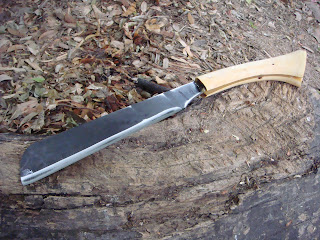Some of you are probably wondering: Why bother? After all, machetes are not that expensive—unless, of course, you’re talking about the custom jobs that arguably might not be all that much better than the varieties costing less than twenty bucks at the hardware store. Machetes from south of the Rio Grande on into Central and South America are quite functional and long lasting, and if you happen to purchase one in its country of origin will usually go for less than a ten-dollar bill. So then why go through all the trouble of rejuvenating an old and worn out machete when it’s a lot less trouble just to buy a new one. Well, the answer is…there is no practical answer. And you are right on all counts. Except that I wanted to do it because it’s an enjoyable project and will probably be the last machete I ever bring back to life. The blade has the name Collins & Co. stamped on it with LEGITIMUS imprinted overhead and above that what looks like a crown and a mallet. A collector would know what all that means but I’m no collector—at least not in that sense. When I got my hands on the blade the steel was pitted and had seen the business end of a mill file perhaps a few hundred times. Someone had also removed the original handle. I annealed the steel, heat treated and tempered to about 50 Rc and re-contoured the handle and cut the blade.
You can see the Collins machete above the Ontario Knife Co. machete I wrote about in the previous post.
The above photo shows you how I planned to cut the handle to create the curved shape ala parang style I enjoy. Notice also that I’ve already made the initial cut at the tip.
This photo shows the finished metal work with the tang reshaped and the blade tip with its final cut.
And here’s the finished machete all ready to go out and take another walk through the woods with me. The handle is chaparro prieto (Acacia rigidula) a common wood in the region. The handle sections are held together via two stout nails I cut and turned into pins, and with an epoxy amalgam of wood dust from a plant called uña de gato, cat claw or Wright’s acacia (Acacia wrightii).
The blade measures eleven inches long. The handle measures 6 ½ inches long. Overall length is 17.5 inches.
Here’s the Collins refurbished machete alongside its cousin the Ontario Knife Co. machete I wrote about in the previous post. Both machetes have sloping handles as seen on your typical Malaysian parang. Of course, the Collins machete is a flyweight compared to the robust parangs of Malaysia. Paul from www.junglecraft.com.my tells me that his parangs are in the 4-5 millimeter range in thickness. That’s one heck of a blade. The Collins blade is only about 1.75 mm thick. Still, on those days when the sun seems to rest just above tree level (brushland trees aren’t very tall) and the wind stirs up a fair amount of dust and not even the flies are out it’s nice to tote an ultra-light machete. The handle on this one feels like the grip on a custom made classic stocked rifle. And once you grip a machete with a handle like the one on this blade you’ll never go back to carrying the run-of-the-mill handles found on the store breeds. This machete probably saw hard use in former times. But now I’ll just sling it over my shoulder in a reinforced canvas sheath and we’ll roam the backlands keeping quiet and checking sign. Maybe we’ll whack a nopal pad out of the way or trim some thorns from an ornery shrub. We’ve got thorns on just about everything around here.

























